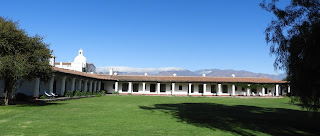 |
| Rock formations outside Cafayate |
We started our day with a flat tire—probably no surprise
given the rocky road we traversed yesterday.
Cafayate has no Hertz office, no gas station that fixes tires and no
tire store. So, I called our travel
agent who called Hertz who called someone in Cafayate who said he could help us
get a new tire for our 160 mile drive to Salta.
When we pulled up to the repair shop, the guy Hertz called was waiting
for us, so I called our travel agent, who talked to him in Spanish and off he
went to get the replacement tire. Two
hours after we first attempted to leave, we were on the road to Salta, feeling
much happier with 2 tires that held air.
 |
| red rocks near Cafayate |
Cafayate is a small town, center of one of Argentina’s major
wine regions. It is a bit nondescript,
but does have a wine museum and a pretty plaza lined with restaurants and a few
shops.
 |
| jumbled rocks and colors |
The real lure of Cafayate is not just the fine
wineries here and the beautiful wine hotel where we stayed last night, but also
the spectacular drive between Cafayate and Salta. I know I’ve used that word a lot in this part
of the Andes, but it’s accurate, as the mountains and formations you drive
through all over this region are truly stunning in their shapes, geology,
massiveness and colors.
This drive equals the others in making you marvel at what
the earth has done to itself. We drove
through huge canyons and deep gorges, stopping to photograph the scenery. When we bring a group here, we will try to
get a naturalist/geologist to come with us to explain the breathtaking world
we’ll drive through.
 |
| Patios del Cafayate, lovely wine hotel |
Once back in Salta, we found our way through the traffic and
potholes to the beautiful central plaza, but didn’t have time to do any
sightseeing as we were already late, and couldn’t find a place to park
anyway. It was 2:30 and we were hungry,
so when we did finally find a parking place, we were on the lookout for a
café. A woman beckoned us into her
courtyard. Inside, she had turned her
small home into a restaurant with 5 tables in the former living room/kitchen and
1 table in the former interior courtyard, now the kitchen.
 |
| uplifted red rocks |
They made space for us and brought us delicious empanadas. We wanted water, so one of the boys serving
patrons (probably a son) went off to the nearest store and bought a large
bottle for us.
Of course, we needed the bano after a long drive. The lady took us into the rest of her house,
where her family lives, to use their bathroom.
But, first, she had to protect us from a very large and very old dog who
only liked her and growled quietly all the time we were there. The bathroom sink didn’t work, but everything
else did, so we were happy even if we disturbed the dog’s rest.
 |
| House of Jasmine, our estancia hotel in Salta |
Now we’re at the Salta airport waiting for our very delayed
flight to Buenos Aires. Of course,
Aerolineas said the flight was on time until just about departure time, when
they announced it would be 2 hours late.
Right now, the time we were supposed to leave, they’re boarding their
earlier flight to BA, also 2 hours late.
Being on time is not a priority for Aerolineas, as we’ve found when
we’ve flown them in the past. It’s why
I’ve decided never to trust a same-day connection to our flight home, even with
10 or 12 hours to do so. We’ve had too
many close calls and today we would have missed our flight home. So, when we eventually get to Buenos Aires,
we’ll spend what’s left of the night and leave tomorrow night for home. We're excited to be staying once again at our favorite hotel in Buenos Aires, the Hub Porteno, a very small, beautiful hotel, with huge suite rooms on a quiet street in the Recoleta district. We recommend it to everyone.
 |
| valley on the way to Salta |









































